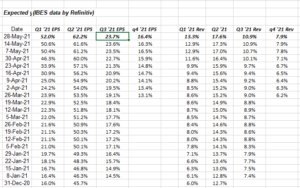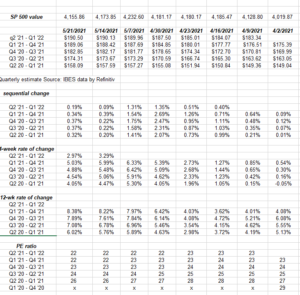Let’s go through the tables quickly:
EPS and revenue growth rate revisions:
Data source: IBES by Refinitiv
Note that Q2 ’21 “expected” for the SP 500 has risen from 16% on December 31 ’20 to 52% as of Friday, May 21, 2021.
Officially the Q1 ’21 SP earnings season is officially over with Walmart’s report this past week.
The “upside surprise” (actual versus expected EPS by individual company) will likely continue through July – August ’21 given the comparisons from a year earlier.
SP 500 forward EPS curve:
Data source: IBES data by Refinitiv
The 4-week rate of change has slowed a smidge, but the 12-week is strong.
SP 500 Bottom-up estimate trends:
Data source: IBRES data by Refinitiv
Readers occasionally ask for 2022 and 2023 estimates. Here are the week-by-week trends.
Expected sector growth rates for 2021:
If readers want to see changes in expected sector growth rates for 2021 since 12/31/20.
Energy’s strength is a function of the weakness last year.
Summary / conclusion: There is little change to the upward pressure on core SP 500 quarterly and annual EPS estimates and the positive revisions. This trend has been going on for well over a year and continues unabated.
Be careful extrapolating the data to a rosy future for the SP 500 given the 55% cumulative return for the SP 500 for 2019 and 2020 and the 105% cumulative return for the Nasdaq 100 for the same period.
In terms of the data, I would expect some differences to start to show themselves after the Q2 ’21 earnings reports by the SP 500 companies as the companies start to face tougher comp’s beginning with Q3 ’21 and beyond.
That being said, the sell-side analyst community has GROSSLY underestimated the strength within the SP 500 components the last 12 months. And I’m not blaming them for that: the pandemic was unprecedented and America was greatly disrupted by the quarantining and work-from-home initiatives.
For those readers worried about inflation, the 10-year Treasury yield is still below the March ’21 highs of 1.75%.
We’ll see.
Take everything you read with a grain of salt on any blog. Invest based on your own financial profile and your appetite for volatility.
Thanks for reading.



